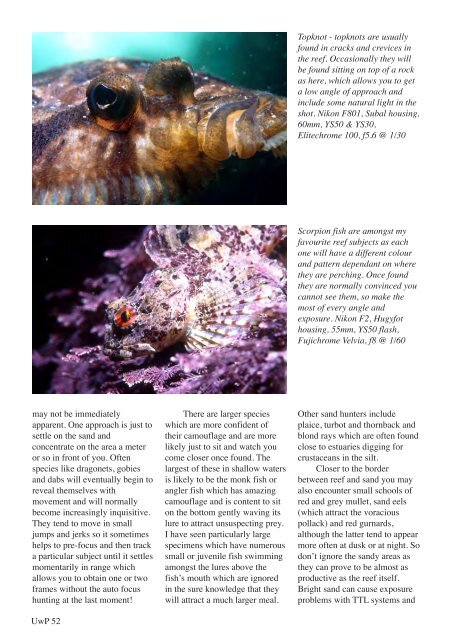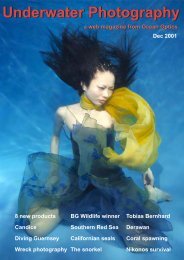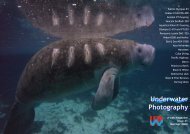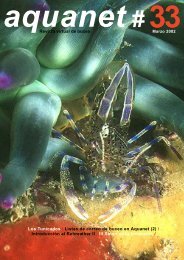Underwater Photography Underwater Photography
Underwater Photography Underwater Photography
Underwater Photography Underwater Photography
Create successful ePaper yourself
Turn your PDF publications into a flip-book with our unique Google optimized e-Paper software.
Topknot - topknots are usually<br />
found in cracks and crevices in<br />
the reef. Occasionally they will<br />
be found sitting on top of a rock<br />
as here, which allows you to get<br />
a low angle of approach and<br />
include some natural light in the<br />
shot. Nikon F801, Subal housing,<br />
60mm, YS50 & YS30,<br />
Elitechrome 100, f5.6 @ 1/30<br />
Scorpion fish are amongst my<br />
favourite reef subjects as each<br />
one will have a different colour<br />
and pattern dependant on where<br />
they are perching. Once found<br />
they are normally convinced you<br />
cannot see them, so make the<br />
most of every angle and<br />
exposure. Nikon F2, Hugyfot<br />
housing, 55mm, YS50 flash,<br />
Fujichrome Velvia, f8 @ 1/60<br />
may not be immediately<br />
apparent. One approach is just to<br />
settle on the sand and<br />
concentrate on the area a meter<br />
or so in front of you. Often<br />
species like dragonets, gobies<br />
and dabs will eventually begin to<br />
reveal themselves with<br />
movement and will normally<br />
become increasingly inquisitive.<br />
They tend to move in small<br />
jumps and jerks so it sometimes<br />
helps to pre-focus and then track<br />
a particular subject until it settles<br />
momentarily in range which<br />
allows you to obtain one or two<br />
frames without the auto focus<br />
hunting at the last moment!<br />
UwP 52<br />
There are larger species<br />
which are more confident of<br />
their camouflage and are more<br />
likely just to sit and watch you<br />
come closer once found. The<br />
largest of these in shallow waters<br />
is likely to be the monk fish or<br />
angler fish which has amazing<br />
camouflage and is content to sit<br />
on the bottom gently waving its<br />
lure to attract unsuspecting prey.<br />
I have seen particularly large<br />
specimens which have numerous<br />
small or juvenile fish swimming<br />
amongst the lures above the<br />
fish’s mouth which are ignored<br />
in the sure knowledge that they<br />
will attract a much larger meal.<br />
Other sand hunters include<br />
plaice, turbot and thornback and<br />
blond rays which are often found<br />
close to estuaries digging for<br />
crustaceans in the silt.<br />
Closer to the border<br />
between reef and sand you may<br />
also encounter small schools of<br />
red and grey mullet, sand eels<br />
(which attract the voracious<br />
pollack) and red gurnards,<br />
although the latter tend to appear<br />
more often at dusk or at night. So<br />
don’t ignore the sandy areas as<br />
they can prove to be almost as<br />
productive as the reef itself.<br />
Bright sand can cause exposure<br />
problems with TTL systems and

















